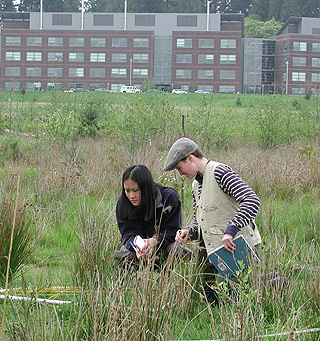|
Subscribe / Renew |
|
|
Contact Us |
|
| ► Subscribe to our Free Weekly Newsletter | |
| home | Welcome, sign in or click here to subscribe. | login |
Environment
| |
October 5, 2004
Students test skills on local projects
Journal Staff Reporter

Photo courtesy University of Washington Restoration Ecology Network
Aeri Hodges (left) and Holly Zox survey species cover and vegetation diversity at the UW Bothell campus wetland restoration area in spring 2003. Zox is now a part-time environmental science instructor at Everett Community College.
|
A University of Washington program pairs students with real clients on ecological restorations, which students design and then make happen.
This educational model caught the attention of Society of Ecological Restoration International, which presented the university with its John Rieger award last month in Victoria, British Columbia.
The program is targeted at seniors. Each year six to seven projects run from September to June. Two faculty members led the way to get it started five years ago when they won a $350,000 "tools for transformation" grant from the university. Bothell-based associate professor Warren Gold and Kern Ewing, a professor in the college of forest resources at the Seattle campus, came up with the idea after asking environmental consultants and agency staff the same question: What kind of people do you need?
| What do the students say? |
|
“It was great to see the fruits of our labor.”
— Tanya Littlefield “I felt as if we really did something important… I believe that it’s important for students to understand that there is always some sort of ‘client’ to deal with.” — Lorraine Leever Brooks “…This type of communication experience cannot be taught in the classroom or be found in a textbook.” — Peter King |
Answers were variations of the same theme, said Gold: People who can work with people of other disciplines.
The Restoration Ecology Network, or REN, teams students from different academic backgrounds for the 25-credit certificate course. Faculty members select small scale projects and choose clients that lack the resources to hire professional consultants.
Faculty members guide them, but students work with clients to design the restorations.
Student teams led conversion of a gravel pit along the Nisqually River to a wildlife forage area, for example. They've also restored city parks and school grounds around Puget Sound.
"Some of the better (restorations) we've seen are at Licton Springs Park," said Gold. "We've done a couple of really nice projects at the Earth Sanctuary up on Whidbey Island. A couple at Frink Park, south Seattle, a very nice one at Evergreen school." Areas that respond well to restoration have become sites for new projects.
"It's more than just planting and weeding," said Gold. Students might amend soils or use bioengineering to contour slopes. Writing a work plan is the biggest part of the project.
| Here's a look at past projects |
|
• Evergreen School, Shoreline
Before: Degraded stream behind school. After: Stream banks shaded with native vegetation. The school wanted to renew a small forested wetland, a stream, a small biofiltration swale and two constructed storm water detention ponds. Students designed the project. A “trail of discovery” showcases native Northwest plants. • Frink Park wetland restoration, Seattle Before: Forested area invaded with non-native plants. After: Native wetland vegetation. A 40-square-meter site was dominated by non-native species such as yellow iris, nightshade, Himalayan blackberry and English ivy. The students worked to increase native plant diversity and enhance wildlife habitat. They worked with students and teachers at Garfield High School and The Friends of Frink Park, a community group. • Fern Hollow Stream restoration, Mercer Island Before: Degraded wet meadow. After: Invasives removed from forest. A site next to Fern Hollow Creek was invaded by English ivy and creeping buttercup, both non-native species. The stream was also heavily silted, as there had been construction upstream with inadequate control measures. Students bioengineered erosion control and removed invasive species. • Licton Springs wetland restoration, Seattle Before: Invasives encroaching boardwalk and springs. After: Spring recovered and natives installed. Human traffic degraded the area around a mineral spring. Students removed non-native vegetation downslope of the spring and wrote a maintenance manual for the Licton Springs Community Group. For more information, see http://depts.washington.edu/uwren/index.htm. Contact Warren Gold at (425) 352-5409 or wgold@u.washington.edu. Gina Diamond, program coordinator, can be reached at (206) 616-2461 or uwren@u.washington.edu. |
Gold said students think design of species and habitat features will be the hardest part of the project, but soon see what's harder is talking to each other.
"They find... the largest challenges come in people management — working within your group, working effectively with your client," he said. "Communication ends up being a much larger part of a successful project than they had anticipated."
Students aren't the only ones learning new lessons.
Reflecting on five years' worth of projects, Gold admits some sites have not been so successful, -- especially when students graduate and there is no one to maintain the newly restored sites.
That's why community stewardship is so important, he said. A project works in the long term if it's in the care of people who accept the responsibility to maintain it.
Too often restoration is seen as simply "stepping into nature, digging holes and putting plants in the ground," Gold said. "People shake hands. Then they walk away."
But the first five to seven years are critical. Coming up with a plan to keep new sites monitored and maintained, and sometimes finding the people to do that work, is part of what UW students have to do to earn certificates.
"These aren't ‘let's get the Boy Scouts out and plant' weekend projects," said Gold.


